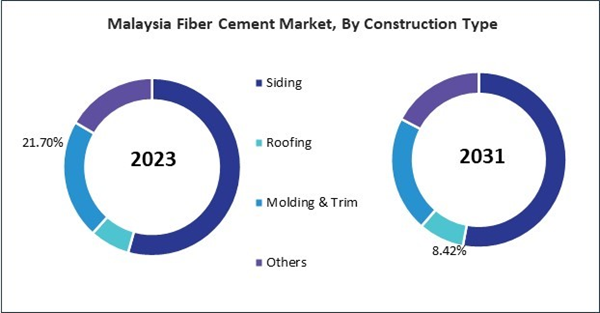Portland cement, a key component in fiber cement production, is made primarily from limestone, clay, and gypsum. The process begins with the extraction of limestone and clay from quarries, which are then crushed and blended in precise proportions to form a raw mix. This raw mix undergoes a heating process in a kiln at temperatures exceeding 1400°C, transforming it into clinker, a nodular material. After cooling, the clinker is ground into a fine powder along with gypsum, a mineral additive, to regulate setting time. Thus, the China market consumed 8,855.7 kilo tonnes of Portland cement in 2023.
The China market dominated the Asia Pacific Fiber Cement Market by Country in 2023, and would continue to be a dominant market till 2031; thereby, achieving a market value of $3,471 million by 2031. The India market is registering a CAGR of 4.4% during (2024 - 2031). Additionally, The Japan market would showcase a CAGR of 3.7% during (2024 - 2031).
Urbanization often necessitates the construction of high-rise buildings and skyscrapers to maximize land use and address housing and commercial space demands in densely populated urban centers. This cement products are favored for their durability, fire resistance, and design flexibility, making them suitable for tall buildings where safety, performance, and aesthetics are paramount.
Furthermore, this cement is considered environmentally friendly as it is made from natural materials such as cement, cellulose fibers, and sand. Additionally, it is recyclable and contributes to green building practices, aligning with sustainability goals in the construction industry. Infrastructure projects such as roads, bridges, utilities, and public buildings require durable and resilient materials like this cement. Its use in infrastructure development contributes to the growth of the market, driven by the increasing investment in infrastructure projects.
According to the report titled Cities as Engines of Growth, published in 2022 by the Government of India, the population of urban areas in India is projected to have increased approximately fourfold, from 109 million in 1970 to 460 million in 2018. The country is projected to experience an additional 416 million inhabitants in its urban areas by 2050, resulting in a 50 percent urban population share. It is already the second-largest urban community globally. Therefore, due to the above-mentioned factors, the market will grow significantly in this region.
Based on End Use, the market is segmented into Non-Residential and Residential. Based on Raw Material, the market is segmented into Portland Cement, Silica, Cellulosic Fiber, and Others. Based on Construction Type, the market is segmented into Siding, Roofing, Molding & Trim, and Others. Based on countries, the market is segmented into China, Japan, India, South Korea, Australia, Malaysia, and Rest of Asia Pacific.
List of Key Companies Profiled
- Knauf Gips KG (Gebr. Knauf KG)
- Beijing New Building Materials Public Limited Company
- Etex NV
- Swisspearl Group AG
- Saint-Gobain Group
- Toray Industries, Inc.
- CSR Limited
- Nichiha Corporation
- SHERA Public Company Limited
- Beijing Hocreboard Building Materials Co. Ltd.
Market Report Segmentation
By End Use (Volume, Kilo Tonnes, USD Billion, 2020-31)- Non-Residential
- Residential
- Portland Cement
- Silica
- Cellulosic Fiber
- Others
- Siding
- Roofing
- Molding & Trim
- Others
- China
- Japan
- India
- South Korea
- Australia
- Malaysia
- Rest of Asia Pacific
Table of Contents
Companies Mentioned
- Knauf Gips KG (Gebr. Knauf KG)
- Beijing New Building Materials Public Limited Company
- Etex NV
- Swisspearl Group AG
- Saint-Gobain Group
- Toray Industries, Inc.
- CSR Limited
- Nichiha Corporation
- SHERA Public Company Limited
- Beijing Hocreboard Building Materials Co. Ltd.
Methodology

LOADING...









